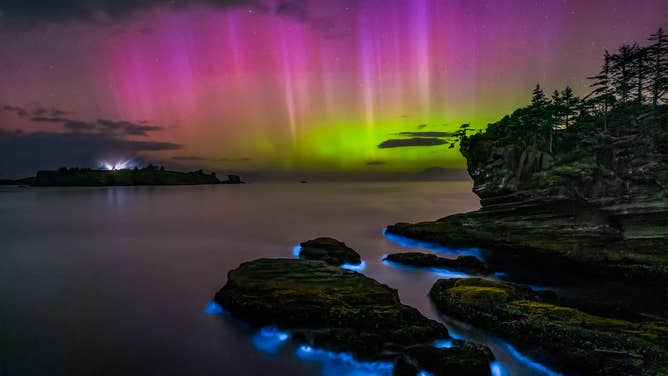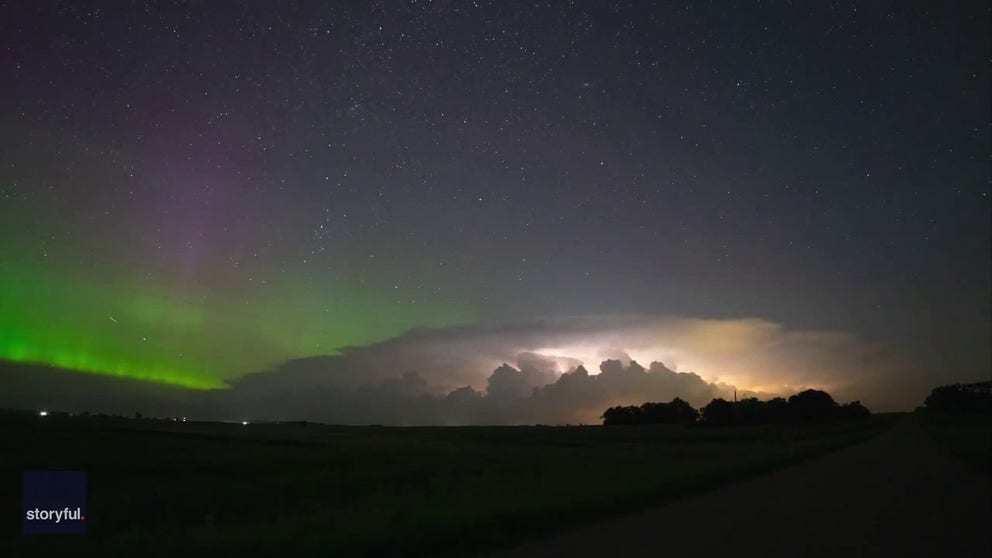Northern Lights dance above lightning and bioluminescence
When space weather and natural phenomenon on Earth combine, the sights can be awe-inspiring. U.S. photographers captured two recent examples of the Northern Lights dancing above lightning and bioluminescence lights.
Aurora dances behind lightning in North Dakota
Timelapse video shows aurora lights dancing under the starry sky of Aneta, North Dakota, with lightning flashing from a large supercell. (Video: Elan Azriel via Storyful)
Two photographers with impeccable timing recently captured all-natural light shows when the glowing auroras danced above lightning in North Dakota and bioluminescence lights in Washington.
Elan Azriel in Aneta, North Dakota, was in the right place at the right time when he recorded the time-lapse video above. The green, purple and red hues of the Northern Lights made a powerful backdrop to thunderstorms happening in the distance.
"I witnessed a strong thunderstorm producing frequent lightning and incredibly rare red sprites. Behind this storm, the aurora danced brightly, creating a rare and beautiful scene," Azriel said of the video.
7 THINGS TO KNOW ABOUT THE NORTHERN LIGHTS
Azriel's reference to "sprites" describes the mysterious flashes that happen above thunderstorms. Sprites can look like bolts of red lighting or take on the shape of jellyfish.
Aurora Borealis, or the Northern Lights, happen in the Northern Hemisphere and are caused when charged particles from the sun create solar wind that eventually crashes into Earth's atmosphere.
The color of the lights will vary from green or yellow to red and purple, depending on the type of gas molecules in Earth's magnetic field.
Auroras mostly happen in areas near the polar regions, but a strong solar flare can create auroras in the Northern Tier.
Incredible photo combines Northern Lights with bioluminescence

The Northern Lights shine atop a blue glow of bioluminescence at Cape Flattery, Washington on July 25, 2023.
(Mathew Nichols Photography / Facebook / FOX Weather)
Patience paid off for a photographer who braved hours perched on a precious cliff in the dark along the rugged Washington coast, waiting for an experience that he described as a "show of a lifetime."
With active solar activity in the forecast Tuesday night, Mathew Nichols ventured out to the rocky cliffs of Cape Flattery in the hopes of capturing a glimpse of the Northern Lights at the same time the ocean waters glowed blue with bioluminescence.
"I spent over 5 hours on a rocky cliff staring at the sky and this lighthouse in the middle of the night waiting for my chance to get this shot," Nichols said. "For the first few hours, clouds looked like they were going to ruin the show."
TIPS FOR SPOTTING THE NORTHERN LIGHTS
But he said he stayed patient on a "very uncomfortable cliff" and anxiously awaited some cloud cover until the aurora began dancing across the northern horizon.
"The Aurora Borealis started off kind of weak and then surprised me with this INCREDIBLE display," Nichols wrote.
GLOWING REVIEW: EXPLORING THE BEAUTY OF BIOLUMINESCENCE
Nichols has been to the coast many times to capture bioluminescence – the blue tinge in the waters was from living organisms producing light.
"Bioluminescence is when living organisms produce light, so they have the chemistry within their cells, their bodies to have a chemical reaction that involves (the) release of energy comes out as light that we can see," said Michael Latz, a marine biologist at Scripps Institution of Oceanography through the University of California, San Diego.
The single-celled plankton, called dinoflagellates, release that energy when excited by wave action.
"This (photo) goes to show that good things come to those who have patience," Nichols said.
